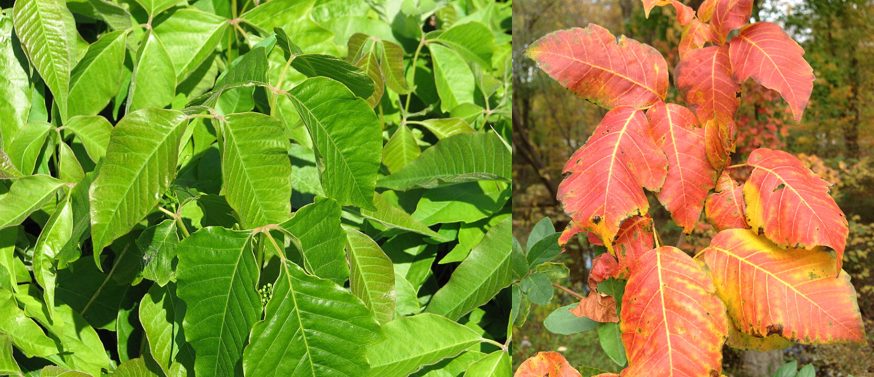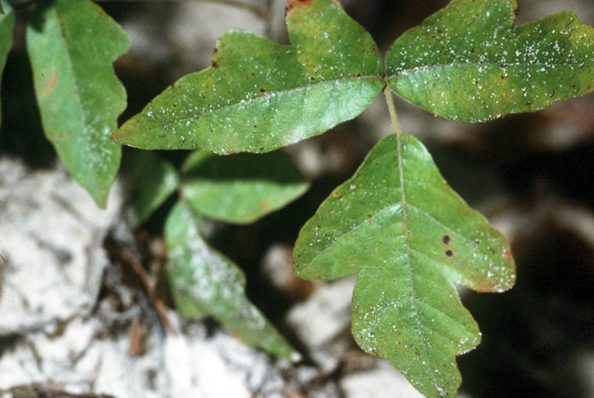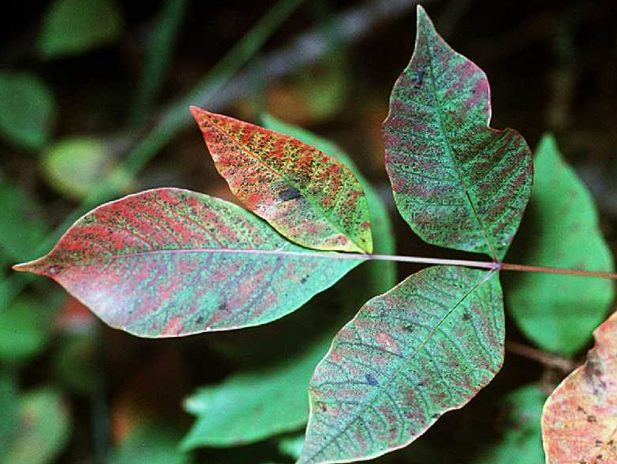Coming into contact with poison ivy, oak, or sumac is common for those living near Willow Grove, PA. More than likely, you have encountered one of these plants. All three of these poisonous plants contain urushiol. This odorless and colorless oil causes the itching rash people get when they come in contact with it. About 25% of the population can have a severe reaction to this oil, which can cause severe symptoms. 15% of the population will have less of a reaction and no reaction at all from Urushiol.
This oil can remain active on the skin, clothes, and surfaces. Even if you are not allergic to or have no reaction to poison ivy, oak, or sumac, you can inadvertently leave it on surfaces and give someone else a rash. With that in mind, it is best to try to avoid these plants.
How can I tell poison ivy, oak, or sumac apart from each other and other plants?
Poison Ivy
- Eastern poison ivy, Toxicodendron radicans, found throughout Pennsylvania
- Grows on the ground or can climb as a vine
- Most common along rivers and lakes but can grow almost anywhere.
- Identified by four characteristics:
- Clusters of three leaflets
- No thorns
- Alternate leaf arrangement
- Each group of three leaves grows on its stem and then connects to the main vine.

Poison Oak
- Atlantic poison oak, Toxicodendron pubescens, can grow in Pennsylvania’s southeastern and south-central parts. This area is generally as far north as it can grow.
- Appears as an upright shrub 3 feet tall with 6-inch leaves grouped in three.
- Leaves are usually hairy and appear as white oak leaves that turn orange in autumn.

Poison Sumac
- Toxicodendron vernix, also known as Swamp-Sumac, it can be found in eastern Pennsylvania and other isolated locations in central and western parts of the state.
- More often found in very wet locations
- It appears as a small tree or woody shrug and can grow to be 30 feet tall.
- It can have 7 to 13 leaves per stem with pointed tips and smooth surfaces.

What are the symptoms of an allergic reaction to poison ivy, oak, or sumac?
Most people develop a rash after touching poison ivy, oak, or sumac. They can also develop a rash if they touch a surface covered with its oil, like a railing, table, clothes, or a pet.
It may take several days for symptoms to appear, and the severity of these symptoms can vary from person to person. The skin will be red and swollen. After that, blisters will appear for a few days and then become crusty and start to flake off. The rash is often very uncomfortable and itchy. A rash cannot spread by touching or scratching it as long as the oil from the poisonous plant has been washed off.
Typically, it takes one to two weeks for someone to recover from poison ivy fully.
How do I treat poison ivy, oak, or sumac?
First, you should immediately wash any exposed areas with soap and water. Avoid taking a bath, as the oil could float on the surface of the water and infect more sensitive parts of the body. It is best to wash off in a shower or hosing off outside. All clothes should be washed to remove any oil from them. Shoes and boots should be cleaned, especially to avoid tracking oil into the house and spreading it on the floor. This can be especially harmful for babies and toddlers crawling along the floor.
If a rash does develop, some things you can do at home to relieve itching include:
- Warm, wet washcloths are in the areas where a rash appears.
- After washing off all traces of the oil, bathe in colloidal oatmeal. This type of oatmeal has been ground into a powder and is widely available.
- Apply calamine lotion on rashes.
- Avoid scratching a rash! Scratching a rash can damage the skin and increase the risk of a skin infection from bacteria.
- Some providers may suggest oral antihistamines for unbearable itching that interferes with getting a good night's sleep.
Come to AFC Urgent Care Willow Grove if a rash spreads to someone's eyes, mouth, or throat. Come immediately to our walk-in urgent care center if you are severely reacting to poison ivy, oak, or sumac. Some severe symptoms can include swollen eyes or face or difficulty breathing or swallowing. If breathing is especially difficult, please seek care at an emergency room.
Patients should also come to AFC Urgent Care Willow Grove if their rash and mild symptoms do not clear up after 14 to 21 days or if their symptoms are getting steadily worse.
How can you avoid or prevent getting poison ivy, oak, and sumac?
The best treatment for these poisonous plants is not coming into contact with them in the first place! Here are some helpful tips:
- Learn what poison ivy, oak, and sumac look like, and avoid places you know where they grow.
- If you have long hair, tie it up so it does not brush against plants and then against your face.
- Wear long-sleeved shirts and long pants if exploring unfamiliar wooded areas.
- Do not burn found wood or plants unless you are positive they are free from poisonous plants. Urushiol, the oil that causes rash, can become airborne if burnt and inhaled, causing a severe and life-threatening reaction.
- Educate children and those unfamiliar with southeastern Pennsylvania to know what these plants look like.
- Encourage children to ask an adult before picking plants or flowers.
Come to AFC Urgent Care Willow Grove today to be evaluated for poison ivy, oak, or sumac. Our experienced providers can help diagnose your rash and provide guidance or medication to alleviate symptoms. Remember, not all rashes are associated with poisonous plants. If you are unsure where they came from, all rashes that linger for more than a few days should be checked out. Call (267) 495-5455 if you have questions.


